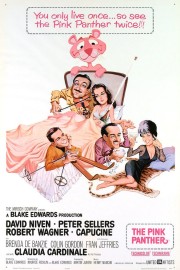The Pink Panther
The name “The Pink Panther” is so well associated with the animated character that made his debut in this film’s opening credits, that it’s easy to forget that the title actually comes from a precious jewel at the center of Blake Edwards’s delightful caper. But watching it again for the first time in many years, I not only found it delightful in its use of the great Peter Sellers as Inspector Jacques Clouseau, but also in its sauciness as a sex comedy. Granted, this isn’t the same level of sexual lunacy he provided in his later film “10,” but it’s just right for the swinging ’60s at the point when James Bond was kicking things up a notch in the bedroom, also. Clouseau is iconic for his sexcapades, as well, but in how spectacularly they fall short, not in how much he succeeds. “A Shot in the Dark” is still better, but this is a great introduction to the character.
The film begins with the titular diamond being passed on from a father to his daughter, Princess Dala (Claudia Cardinale), when she is young. Two decades later, she has been forced into exile by a military coup, and the diamond is considered the property of the people of the country. She disagrees, and we see her go on holiday at a ski resort where she meets an English playboy named Sir Charles Lytton (David Niven). Sir Charles has a secret, however- he moonlights as a notorious jewel thief called the Phantom, and The Pink Panther catches his eye. The Phantom has been on the radar of French detective Inspector Clouseau for quite a while, and it just so happens, he and his wife (Capucine) track him to the same ski resort, where Sir Charles’s nephew, George (Robert Wagner), is also staying. Everyone has some business going on here, and with the exception of Clouseau, nobody has honest motivations other than to themselves.
Henry Mancini was the man. I don’t really think that is something in dispute, but it feels like that, compared to Bernard Herrmann, Franz Waxman or Max Steiner he is undervalued as a great film composer. The way he incorporated jazz techniques and styles into his scores, most famously here, but also in his great work for the classic Orson Welles noir, “Touch of Evil,” is distinctive and instantly memorable to the ear. Now, he is best known for this film’s slinky, wickedly entertaining theme, but one listen to the full score reveals some of the most beautifully classical scoring technique in film music history. His longtime collaboration with Blake Edwards is considered one of the finest by hard core fans, but like his composer, it’s somewhat disconcerting that Edwards, likely because of being best known for comedy (“Breakfast at Tiffany’s” and “Victor Victoria” are also his), is also less considered among the greatest filmmakers of all-time. The man understands comedy inside and out, and he delivered the goods time and again. That said, it was Sellers who sells Clouseau and “The Pink Panther” best, especially when he is trying desperately to get his wife, who is having an affair, in the mood for romance. Those are some of the funniest parts of the movie, as is when the Princess is fending off the advances of Sir Charles while lying atop a tiger skin rug where the tiger seemed like a goofy one. Few filmmakers understood the ways sex could be funny without being lewd- Edwards makes it look easy, even if for Clouseau, it’s anything but.










